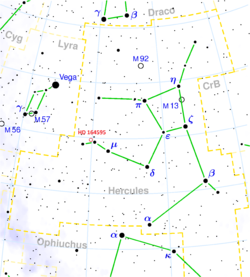| Observation data Epoch J2000 Equinox J2000 | |
|---|---|
| Constellation | Hercules[1] |
| Right ascension | 18h 00m 38.894s[2] |
| Declination | +29° 34′ 18.92″[2] |
| Apparent magnitude (V) | 7.07[1] + 12.538[3] |
| Characteristics | |
| Spectral type | G2 V[4] + M2.5 V[5] |
| B−V color index | 0.635±0.005[1] |
| Astrometry | |
| Radial velocity (Rv) | 2.048±0.0007[6] km/s |
| Proper motion (μ) | RA: −138.982 mas/yr[2] Dec.: 173.502 mas/yr[2] |
| Parallax (π) | 35.402 ± 0.0146 mas[2] |
| Distance | 92.13 ± 0.04 ly (28.25 ± 0.01 pc) |
| Absolute magnitude (MV) | +4.81[1] |
| Details | |
| HD 164595 A (primary) | |
| Mass | 1.081±0.054[7] M☉ |
| Radius | 1.057±0.053[7] R☉ |
| Luminosity | 1.023+0.049 −0.046[8] L☉ |
| Surface gravity (log g) | 4.44±0.05[9] cgs |
| Temperature | 5,790±40[9] K |
| Metallicity [Fe/H] | −0.06[9] dex |
| Rotational velocity (v sin i) | 0.1[8] km/s |
| Age | 4.5[9] Gyr |
| HD 164595 B (secondary) | |
| Mass | 0.455±0.046[3] M☉ |
| Radius | 0.464±0.018[3] R☉ |
| Temperature | 3,648±21[3] K |
| Rotation | 43.486848 d[10] |
| Other designations | |
| Database references | |
| SIMBAD | data |
HD 164595 is a wide binary star[12] system in the northern constellation of Hercules.[1] The primary component of this pair hosts an orbiting exoplanet. The system is located at a distance of 92 light years from the Sun based on parallax measurements,[2] and is drifting further away with a radial velocity of 2.0 km/s.[6] Although it has an absolute magnitude of +4.81,[1] at that distance it is too faint to be viewed with the naked eye, having an apparent visual magnitude of 7.07.[1] The brighter star can be found with binoculars or a small telescope less than a degree to the east-northeast of Xi Herculis.[13] HD 164595 has a relatively large proper motion, traversing the celestial sphere at an angular rate of 0.222″ yr−1.[14]
The spectrum of the primary, component A, presents as a G-type main-sequence star with a stellar classification of G2 V.[4] It is considered an excellent solar twin candidate,[15][16] although it has a lower logarithm of metallicity ratio, at −0.06 compared with 0.00, and a slightly younger age, at 4.5 versus 4.6 billion years.[9][17][a] The estimated mass, radius, and luminosity of this star are all similar to the Sun, and the level of magnetic activity in the chromosphere is comparable to solar levels.[15]
The secondary member, component B, is a magnitude 12.5[3] star at a projected separation of 2,509±27 AU from the primary.[12] It is a small red dwarf of spectral class M2.5 V.[5] Periodic variations in the light curve of this star suggest a rotation period of 43.5 days.[10]
- ^ a b c d e f g Cite error: The named reference
Anderson_Francis_2012was invoked but never defined (see the help page). - ^ a b c d e Cite error: The named reference
GaiaDR3was invoked but never defined (see the help page). - ^ a b c d e Cite error: The named reference
Mann_et_al_2015was invoked but never defined (see the help page). - ^ a b Cite error: The named reference
mkwas invoked but never defined (see the help page). - ^ a b Cite error: The named reference
Alonso-Floriano_et_al_2015was invoked but never defined (see the help page). - ^ a b Cite error: The named reference
Soubiran_et_al_2018was invoked but never defined (see the help page). - ^ a b Cite error: The named reference
Kervella_et_al_2019was invoked but never defined (see the help page). - ^ a b Cite error: The named reference
Brewer_et_al_2016was invoked but never defined (see the help page). - ^ a b c d e Cite error: The named reference
aaa563_A52was invoked but never defined (see the help page). - ^ a b Cite error: The named reference
Hartman_et_al_2011was invoked but never defined (see the help page). - ^ Cite error: The named reference
SIMBADwas invoked but never defined (see the help page). - ^ a b Cite error: The named reference
Montes_et_al_2018was invoked but never defined (see the help page). - ^ Cite error: The named reference
Sinnott_Perryman_1997was invoked but never defined (see the help page). - ^ Cite error: The named reference
Lepine_Shara_2005was invoked but never defined (see the help page). - ^ a b Cite error: The named reference
Porto_de_Mello_et_al_2014was invoked but never defined (see the help page). - ^ Cite error: The named reference
Mahdi2016was invoked but never defined (see the help page). - ^ a b Cite error: The named reference
nssdcwas invoked but never defined (see the help page). - ^ Cite error: The named reference
NASA_2013was invoked but never defined (see the help page).
Cite error: There are <ref group=lower-alpha> tags or {{efn}} templates on this page, but the references will not show without a {{reflist|group=lower-alpha}} template or {{notelist}} template (see the help page).
